Electromagnetic motors and drivers are have been optimized for more than 100 years. They can be found applications from toys to aerospace systems. With all their advantages, there are limitations such as magnetic fields (undesirable in certain applications) - reduced efficiency when it comes to miniaturization as well as bandwidth limitations. Piezoceramic motors and transducers can fill these voids and have been adopted in Life-Science and Medical Engineering applications including ultrasound generation / detection, low energy drive components, ultra-fast actuation and high-precision metering in valve and pumping applications.
Piezoceramic transducers and motor drives meet these requirements and have a long track record of ruggedness and reliability in Industries such as Optical Technologies and Semiconductor Manufacturing. In fact, PICMA® piezo actuators were chosen for the Mars Mission after clearing 100 billion cycles of life testing with zero failures.
A few applications for piezo transducers, motors and actuators are:
- Zoom actuators for endoscopes, nanodispenser, pipettors, micropumps, bubble detectors and flow meters, nebulizers, cutting tools in endoscopic piezosurgery
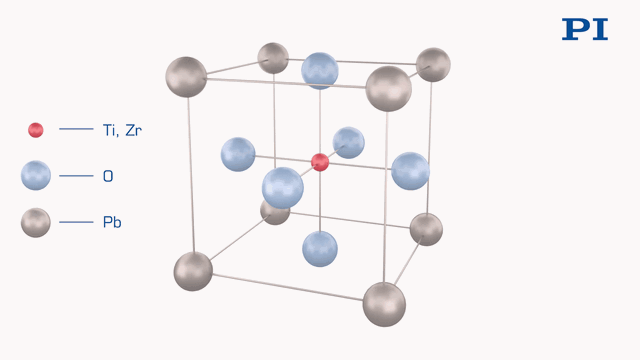
Animation of the solid-state effects inside piezoceramic materials when the electric field is changed (Image: PI)
High Performance Piezo-Driven Diaphragm Micropumps
Micro-diaphragm pumps need miniaturized drive mechanisms which can provide a steady flow and variable flow rates. The small volumes per pumping cycle mean high drive frequencies in the 10’s of kilo Hertz range to achieve high flow rates.
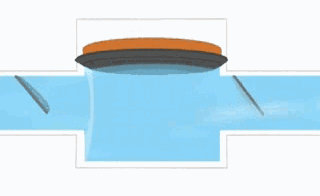
Disk-shaped piezo transducers can be combined with the diaphragm. For larger forces or extensions, a piezo linear actuator can be coupled directly with a piston or a diaphragm.
The continuous, slow motion of infusion pumps can also be produced with piezo drives.

(left) Piezoceramic disks can be attached to the membrane of a micropump and thus move it with high frequency. (Image: PI)
(right) Piezo-transducer driven micro-diaphragm pump for laboratory automation (Image: thinXXS Microtechnology AG)
Micro-Dosing Valves with Piezo Flexure Drives
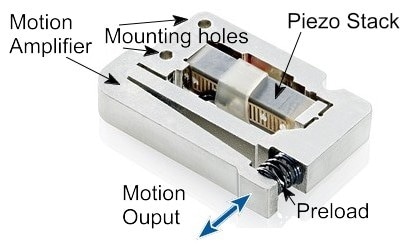
P-604 low-cost piezo flexure OEM actuator (Image: PI)
Micro-dosing valves for nanoliter, or even picoliter, droplets depend on very quick actuation. Piezo-actuators are used in various types of drives: they can operate valves directly, or work against a flexible tubing or strong springs to displace liquid volumes. Mostly, the quicker a valve can be opened and closed, the smaller the volume that can be controlled. Frequencies in the kilohertz range are needed and piezo actuators provide quicker response than electromagnetic drives, such as voice coils or solenoids. The high kinetic energy created by piezo mechanisms can generate ultra-small droplets without subsequent nebulization, dripping or satellite formation. For drop-on-demand techniques similar to ink jet technology, piezo tubes that contract radially when a voltage is applied are available. Valves needing larger strokes can be implemented by piezo flexure actuators with integrated motion amplifier.
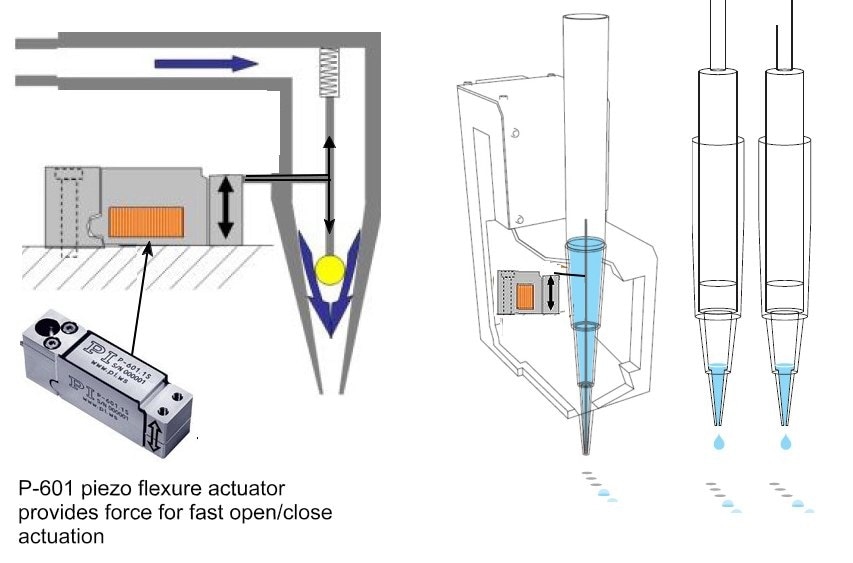
Principle design of a high-speed precision dosing valve for micro-liter to picoliter applications. Piezo mechanics are stiffer and can move faster than solenoids. Piezo flexure amplified actuators provide motion ranges of several 100µm and extremely fast mechanical response to drive signal changes in the order of milliseconds and below. The high speed combined with the virtually unlimited position resolution in the nanometer range provides advantages in open/close speed of valves and also in the dosing precision. (Image: PI)
Another principle is the direct displacement technique used in PipeJet™ dispensers, based on an elastic polymer fluid line with a thin internal diameter driven by high-force PICMA® piezo stack actuators. Since the tube and piezo drive are detached, maintenance is easy and any parts dirtied by fluid can be swapped quickly and cost-efficiently.
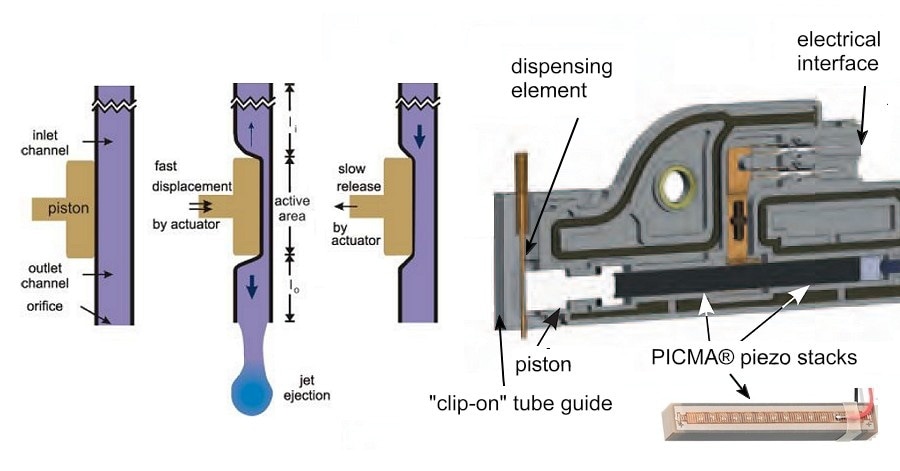
PipeJet micro-dosing pump. This system does not require a valve and is based on a PICMA® piezo-linear-direct drive actuator, displacing the liquid in a flexible tube. (Image: Biofluidix)
Pumps for Outpatient Therapy
Outpatient therapy repeatedly depends on mobile drug pumps for several applications, such as oncology, pain therapy, parenteral nutrition as well as metabolic disorders. Mobility not only enhances the quality of life, but also minimizes therapy costs as the patients do not need treatment at the hospital. There are limitations with conventional mobile drug pumps when it comes to flexibility, weight, size and reliability. Latest advances in drive systems, based on piezo ceramic motors, can help conquer these limitations and pave the way for new opportunities for both medical device Manufacturers and patients.
The concept of compact, mobile drug delivery mostly includes balloon pumps. However, they display major inconsistencies in the medication delivery rate and lack the ability to document the precise injection quantities. Since “mobile” patients are typically not in the hospital, trained persons are there to precisely monitor the course of therapy. The Physician needs accurate data for an effective treatment. Thus, a pump system is required which also allows for precise traceability of medication quantities vs time outside the hospital. For such cases, peristaltic pumps are presently the perfect solution.
However, because of their substantial size and weight, these pumps severely limit the patient’s mobility. They do, however, provide for a precise dosage and programmable, timing and volume flows. The peristaltic pumps are appropriate for various medications, as they supply a continuous flow (basal rate), but even special injections (bolus rates) are also easy to dose and can be programmed in any manner. Furthermore, all procedures can be documented to assess specified drug quantities and the course of therapy and to submit applicable data to insurance providers.
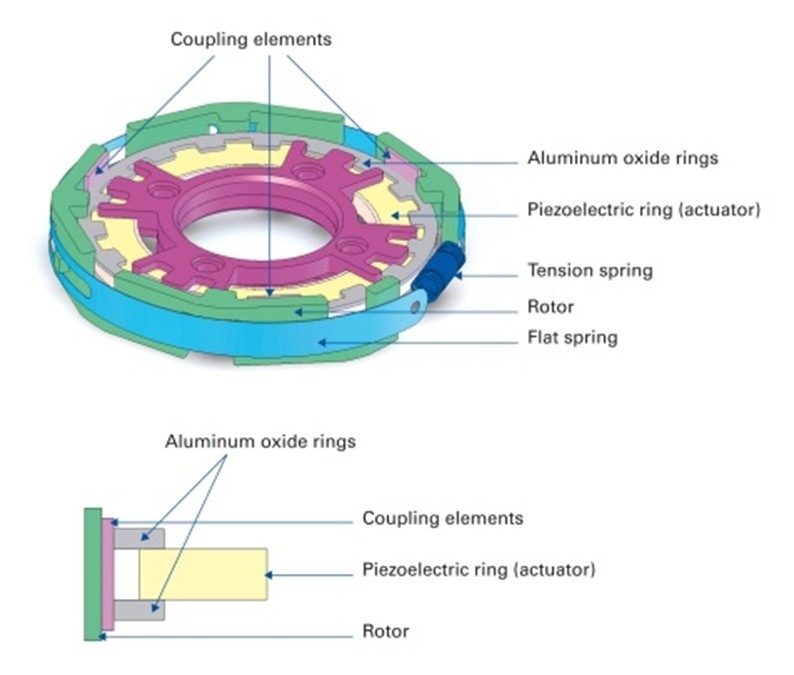
A compact piezoelectric ultrasonic rotary motor for variable drug delivery. The motor consists of a piezoelectric ring actuator excited with a traveling wave. Thin aluminum oxide rings (grey) on top and bottom of the piezo ring absorb the oscillations. With the help of the three coupling elements (pink) used in the rotor, the absorbed oscillations are transmitted to the pre-loaded rotor (green) and converted to a rotary motion. (Image: PI)
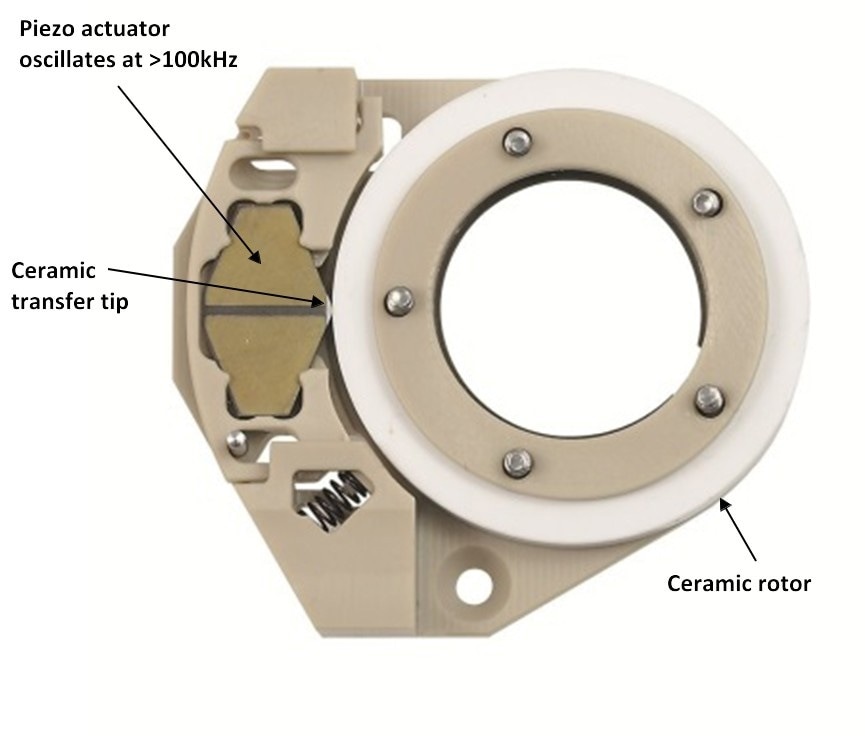
Designs with the piezo actuator mounted radially are also feasible. Inside the large aperture of this ring additional components can be arranged. Drug pumps built in such a manner are particularly small, light and silent. They offer a high degree of flexibility with regard to various therapies and dosages. (Image: PI)
Mobility and Documentation
Apart from mobility, peristaltic pumps integrate all desired requirements – however, the motors used in these pumps can be further improved. Small electric motors with gear-box torque multipliers can produce the essential torque required for pumping, but they are slow and their mechanical micro-gears are susceptible to backlash and wear, needing maintenance and lacking cost efficiency and reliability.
If a gearless electric motor is employed, a larger drive is needed to provide the torque, but the self-locking feature of the gear box is lost and electric current is necessary to retain a steady position when at rest, which can impact battery life.
Operating Principles of Different Types of Piezo Motor Drives
Stick / Slip Piezo Linear Motor Animation - Mini Motor Actuator by www.pi.ws
Ultrasonic Motor Operating Principle PILine Linear / Rotary Piezo Motor by www.pi.ws
Piezo-based ultrasonic direct drives can pave the way for new opportunities here. They are quiet, very compact, low wear, and self-locking, maintaining their position when powered off and even if they are hit, dropped, or shaken. It is easy to comprehend how these compact piezo drives function: oscillations with ultrasonic frequencies of a piezoceramic plate are moved to a moving runner in a rotary or linear motion. The main piece of the drive is a monolithic piezo ceramic (stator), having two electrodes. Either the right or left electrode is electrically excited, in a range of 100 kHz or above, establishing the direction of motion. Each oscillation moves a coupling element linked to the piezo ceramic by a few nanometers. In contact with the runner, the net result of the micro impulses is high-speed motion with extremely high precision.
Various Designs are Feasible
The drive electronics can be incorporated as a chip and needs only very little installation space. Furthermore, the solution is very low-wear and reliable, as there are limited mechanical components, such as gears. An extremely wide speed spectrum allows for a large spread of dosages. Based on the design, dosages can be made from a few degrees up to multiple revolutions per second, or, in the case of linear drives, from <1 mm/second to several 100 mm/second.
Miniature Drives / Pipetting with Uniform Force
As liquid volumes decreases and micro well counts increases, miniaturization of the drives is required together with higher precision for dosing smaller volumes.
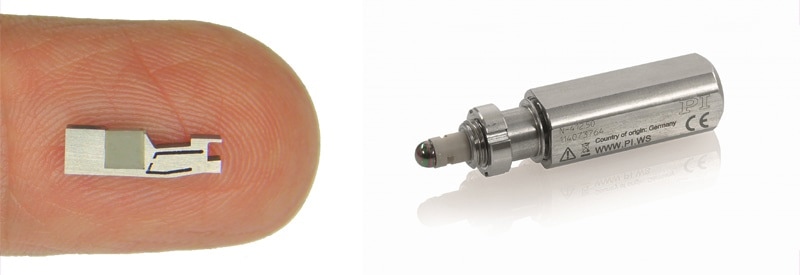
Piezo linear motors can be designed incredibly small. The inertia motor shown on the left provides provide nanometer precision and is ideal for integration into miniaturized drives and instrumentation. A miniature actuator with piezo motor is shown on the right. (Image: PI)
Piezo linear motors can be manufactured sufficiently small to meet these needs, providing even speed and force together with positioning accuracy in the micrometer to nanometer range. The substantial reduction of moving components compared to conventional motor/screw drives minimizes the size and increases the reliability.
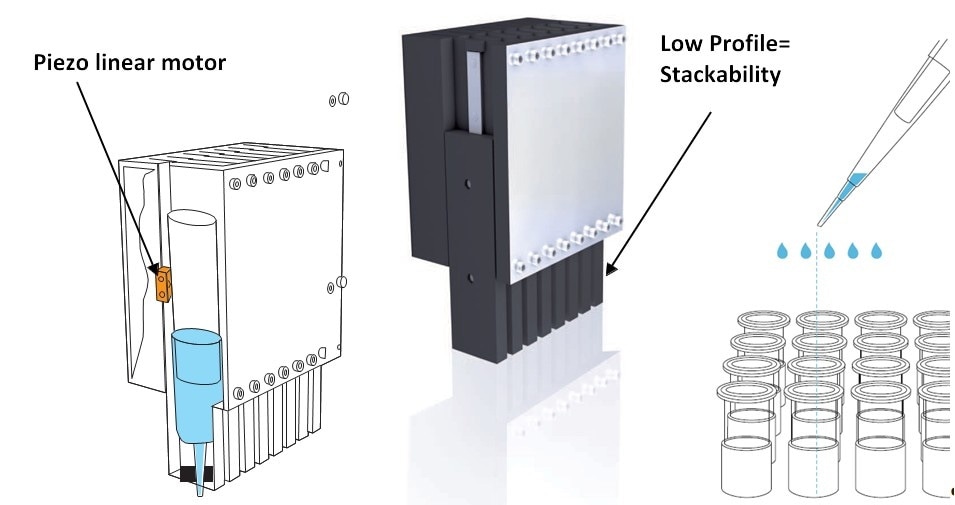
A compact piezo motor drives the pipetting mechanism. The low profile allows for stacking of multiple units. Miniaturization higher dosing precision is advantageous as liquid volumes fall and micro well counts go up. (Image: PI)
Atomizers/Aerosols Generation
Atomizers can provide medication very efficiently to the respiratory tract. The homogeneity of the aerosol is important and piezo-transducer driven membranes oscillating at high-frequency in the ultrasonic range can produce droplets of a predefined size.
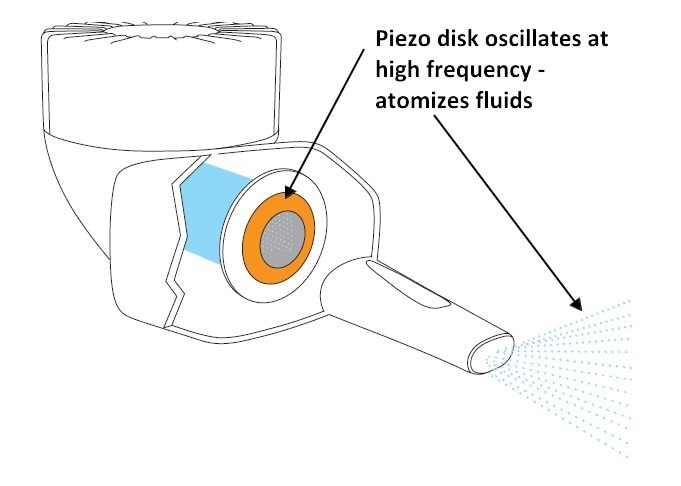
An annular piezo disk excites a perforated membrane with oscillations up to 100 kilohertz. Medication is thus quickly and efficiently atomized. (Image: PI)
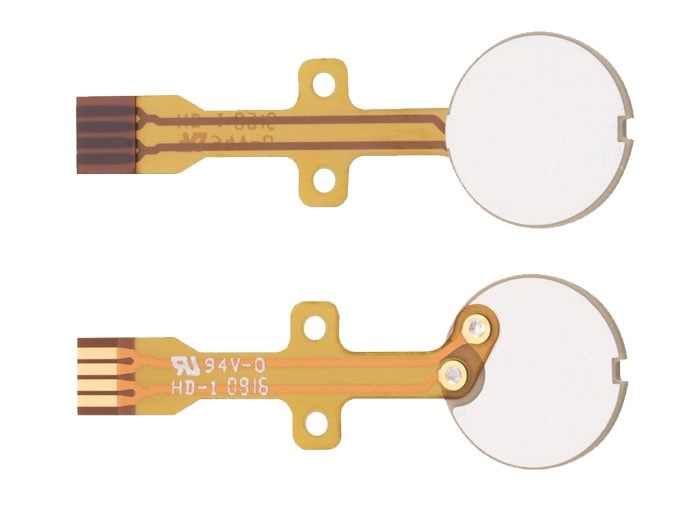
Piezo transducer discs are available with flexible PCB to facilitate integration in volume production. (Image: PI)
Bubble Detection and Flow Measurement
Ultrasonic piezo transducers can be employed to detect impurities or bubbles in dialysis or blood transfusion applications. The direct and inverse piezo effect allows transducers to function as both sensors and actuators (ultrasound transmitters and detectors). There is no direct contact with the fluids and no necessity for maintenance. The piezo transducers can measure the flow velocity as well as detect bubbles.
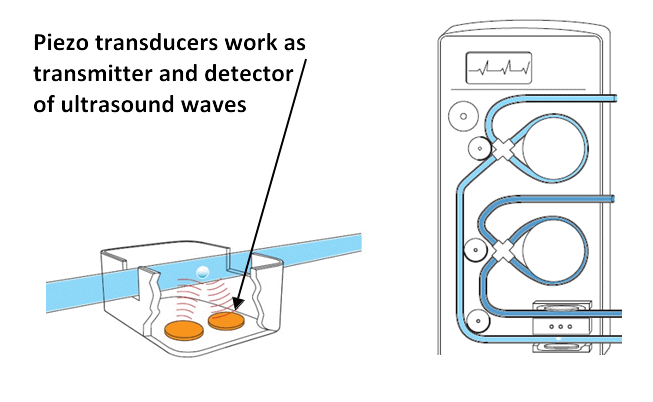
Air In-Line Sensor: The piezo transducer element works both as an ultra-sound generator and detector. The measurement is based on the Doppler Effect: oscillations in the 100kHz range are reflected by the medium. Signal processing electronics can tell frequency offsets and changes in the reflection pattern and reliably measure flow rate and detect air bubbles. (Image: PI)
Piezo Drives for Endoscopy and Ophthalmology
Piezo drives have a number of additional fields, for example, laser beam control in ophthalmology and cosmetic applications, as focusing drives in endoscopy or precision shutters for radiation therapy.
Fast Piezo Mirror Mounts for Laser Beam Steering: Laser Eye Surgery with FSM - Piezo Tip/Tilt | PI
Animation showing a piezo drive in an ophthalmology application.
Piezo ceramic motors neither produce nor are they susceptible to strong magnetic fields. Multi-leaf collimators are used in tumor treatment to minimize side effects of the radiation beam to healthy tissue. Piezo drives are very compact and allow tighter packaging, resulting in an increased leave count and better adjustability of the contour which means higher protection for the patient.
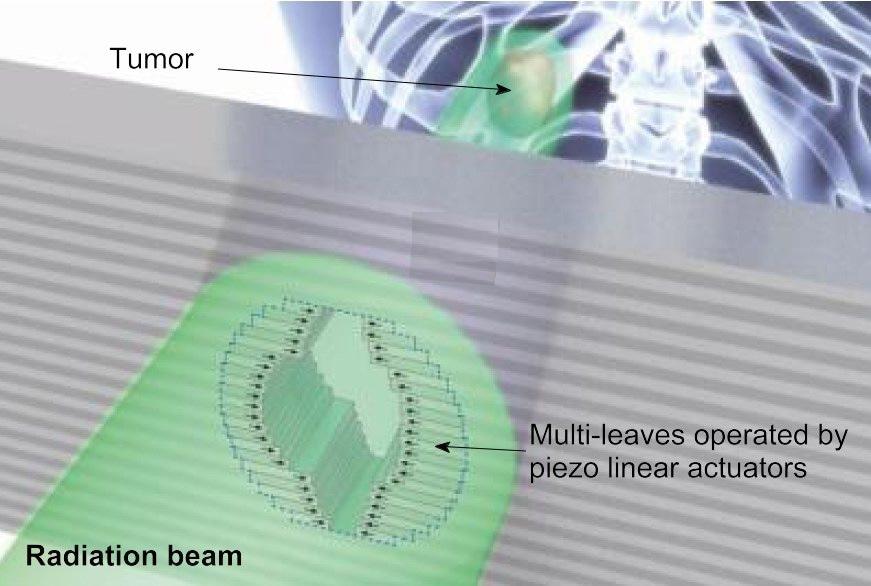
Piezo linear motors can be tightly packaged to control the leaves in a multi-leaf collimator for radiation treatment.
Summary
Piezo technology (actuators, transducers and motors) provides advanced solutions to many motion, dosing, positioning and measuring problems. Piezo elements can directly transform electrical energy into mechanical energy and vice versa. The piezo effect is based on crystalline displacements, with no physical wear and friction. Piezo ceramics are sterile, do not require lubrication and can be baked at high temperatures. Piezo products are integrally vacuum compatible and non-magnetic – all prefect prerequisites for bio-medical applications.
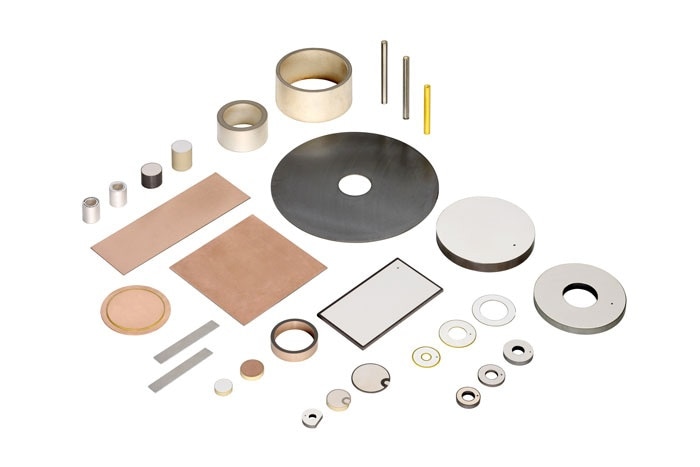
Variety of piezo ceramic transducer disks, rings benders and tubes. (Image: PI)
The Piezoelectric Effect, Manufacturing Processes: How do Piezoelectric Transducers work?
Insights into piezo transducer manufacturing processes at the PI Ceramic factory.

This information has been sourced, reviewed and adapted from materials provided by Physik Instrumente (PI) GmbH & Co KG - Worldwide.
For more information on this source, please visit Physik Instrumente (PI) GmbH & Co KG - Worldwide.